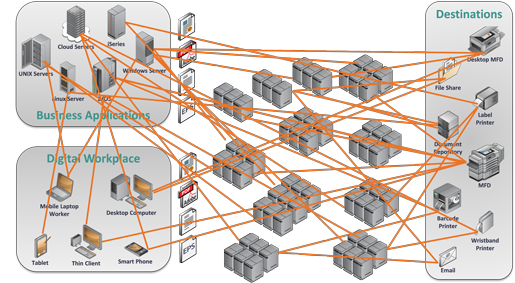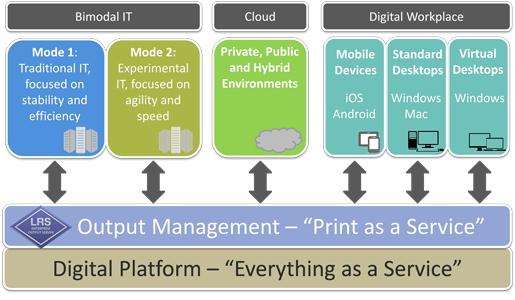So, you’re the new CIO. Congratulations! Now what? Senior management is going to expect some big things in the near future, like helping to transform the business to be more agile in a highly competitive market. What are your big plans for IT transformation? Improving Security? Exploiting public and private cloud technologies? Implementing bimodal IT? Yes, the list is long and the days aren’t long enough (and let’s not even talk about your budget and talent challenges). To be successful as a CIO today, you must think smarter versus harder. You must try new approaches and think out of the proverbial box. Doing things the traditional way will not get you to the finish line, at least not in your professional lifetime.
I’ve got an idea that will help you with your IT transformation projects, and I’m pretty sure that it is something you might not have thought much about. How about implementing “printing as a service.” Yep, you heard me correctly. I suspect that you are trying to connect the dots, so let me help you a little. In the past, IT organizations approached the subject of printing as an afterthought and the resultant print infrastructure is what you have inherited as the new CIO. Let me explain further using the diagram below as a visual reference.
In most organizations, a lot of printing comes from users that create documents from a variety of personal computing devices. In addition, organizations typically have business applications that run on various server platforms. They also have many different kinds of printers, multi-function devices, and other output destinations (e.g., electronic). End users and business applications create output in various formats, and this output needs to be delivered to the correct hardcopy and softcopy destinations. To make this happen, IT organizations like yours created a home-grown, ad-hoc infrastructure that evolved over time with little planning or coordination from different IT departments. It usually consists of many servers running different operating systems and a vast array of connections between this output infrastructure, the upstream applications, and the downstream hardcopy and softcopy destinations.
Typical Print/Output Infrastructure

Because of the complexity of the infrastructure, it’s expensive, prone to failure, and difficult to maintain. It’s also a huge source of frustration for end users when they’re standing in front of a printer wondering why their document hasn’t arrived, with no ability to easily find out why. So much for improving the user experience L.
Why aren’t you aware of these printing problems? The short answer is human nature and organizational silos. Each department spends time and money to plug the holes in the dike, struggling to provide improved services to the business. Why? Because it is their dike – they built it. They are reluctant to change, preferring to maintain the status quo and repeatedly pound a square peg into a round hole. Or, they are simply too busy chopping wood to sharpen the axe. Some are not aware of a better solution, while others assume your MPS provider has it covered. More importantly, none of them is looking at the future, which is where you need to go. Finally, no one person has responsibility for the total enterprise IT infrastructure, except………you!
This kind of “accidental” infrastructure is a millstone around your neck today, and it will be a future obstacle that may prevent you from achieving your critical IT objectives. Do you really want to build on this going forward? I sure hope not, so please consider a different approach.
Every year Gartner conducts a survey of CIOs and CEOs around the world, and they compile their findings and insights into something they call the “CIO Agenda.” They just completed their survey for the upcoming year, and the 2016 CIO Agenda theme is “building the digital platform.” Gartner’s view is that enterprises should look at their enterprise as a set of platforms that address everything from people to technology.
At the bottom of the stack is the “technical platform,” which is ideally comprised of the core technology building blocks and architectures. Borrowing terminology from the cloud computing model, Gartner refers to the concept of “everything as a service” (XaaS). Basically, you need to have a flexible, rock-solid foundation to build on. Need a new server? Spin it up. Need more storage? No problem, here it is on demand. You get the idea. Your technical platform consists of a set of fundamental “services” that additional layers/platforms rely on.
This is where “printing as a service” comes into the picture. You need to view “print” as a single middleware architecture that captures and delivers documents from all applications and platforms to a variety of hardcopy and softcopy destinations. This middleware provides consistent functionality, service levels and user experience across all applications and platforms in the form of a “service layer” that insulates applications from the complexities of document distribution and simplifies the delivery of new services without application changes. You can logically view this service layer as an extension of your organization’s existing IT service catalog.
Now, take this service layer concept and link it to Gartner’s vision of the technical platform, where you have highly modular, open information and technology architectures that provide “everything as a service.” By deploying a standardized print service layer architecture, you now have “printing as a service” as a core capability in your technical platform. This is critical for your document-related business processes, where print plays a critical role. Need to connect a new printer to new applications? Easy. Need to modernize legacy applications that require a print capability? No problem. Need to deliver application output from the cloud? You’re covered. Need a solution to meet the needs of your increasingly mobile workforce? Done. Need to lower costs and staff workload? Check. How about improving the security of document delivery? Relax. It’s all there, on demand and as a single architecture across all platforms, applications, data formats and logical/physical destinations.
Now, compare and contrast your existing print infrastructure (previous diagram) with your future digital platform that includes “print as a service” (seen below).
Building Your Future Digital Platform

Here’s the net message: as you are planning your future digital platform, don’t make the mistake of overlooking print/output management as an opportunity for IT standardization and transformation. Without this kind of capability in your technical platform, you will face an uphill struggle to deliver true business transformation. Instead, projects will be delayed and innovation will be constrained. Why? Because it’s hard to get to the “new” when you are building on the “old.” It’s time to renovate the core and this includes print. LRS can help you get there. The ball is now in your court.